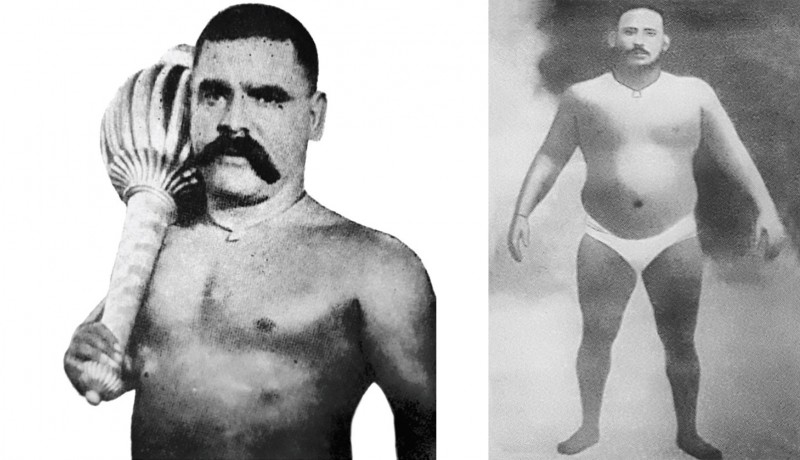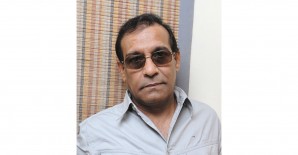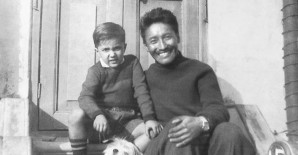
Columns

Raju Mukherji pays tribute to the legendary Gama pehelwan
The first native-born Indians to put India on the world sports map were our wrestlers. Rock-solid men of immense strength. Courageous and crafty. Men of impeccable self-control and discipline.
The legendary grappler Gama pehelwan was the first among Indians to become the heavyweight champion of the world in 1910.
Gama was not his real name. Born in 1880 in Lahore, then the capital of undivided Punjab, Ghulam Mohammed Baksh was sent to Datia in the erstwhile princely state of Holkar (now Madhya Pradesh) at an early age to be under the tutelage of Aziz Meera Baksh, his uncle. The young Ghulam Mohammed was an exceptional fighter of outstanding promise. As he began to win duels and become popular, the modest youngster let it be known that he should not be called Ghulam: “Please do not call me Ghulam. There is only one Ghulam pehelwan. Ghulam bhai is the one and only Ghulam. None else.”
He was referring to the Amritsar-born Ghulam Mohammed, who was under the patronage of the Maharaja of Jodhpur. The senior Ghulam was a magnificent wrestler who spent long hours in meditation. He was a saintly soul with wide knowledge of medicinal roots and herbs. He helped the rural poor in every way he could. He was a deeply respected figure among the wrestling community in India. When the senior Ghulam was asked if he should be addressed as Bade Ghulam in the context of the emergence of the younger Ghulam of Datia, the saintly man merely uttered, “Call me by any name you like. But I shall always remain a ghulam [servant] to the men around me.” This was the classical tradition of the Indian wrestling fraternity: mutual respect and abject simplicity.
Thankfully the junior Ghulam’s guru Aziz Meera Baksh solved the issue in a very logical, sensible manner. The famous and highly respected Ghulam pehelwan of Amritsar-Jodhpur would retain his name and the younger Ghulam of Datia would sacrifice his natural identity and be known as Gama pehelwan. This yet again goes to show the magnanimous attitude of the Indian wrestlers of the time. Since that day, there was no confusion about the identity of the two marvellous wrestlers.
The senior Ghulam Mohammed, born in Amritsar in 1870, was a quiet individual who balanced his time between the akhara mud-pit, deep meditation and Ayurvedic service to the downtrodden. In 1899, Motilal Nehru took him to Paris for exhibition bouts with champions of various nations. Ghulam returned undefeated. But tragedy struck the following year when he was merely 28. He passed away in Calcutta after being stricken by cholera for a few days. Thanks to the munificence of wrestler Gobor Goho’s grandfather Ambika Charan, he was buried with great respect. The remains are still well preserved in the cemetery at Upper Circular Road and the grave is still frequented by the wrestling fraternity.
In late 19th century India, the legend of Gama began. Here was a stocky grappler who could beat all opposition by the sheer use of his awesome physical power. The powerful man would lift his opponent high above his head and throw him down on the mat. None in India could match his phenomenal strength and every opposition was decimated with clinical precision. What’s more, the fearsome wrestler of massive girth was as handsome as he was modest and generous.
Maharaja of Patiala Bhupinder Singh, a great patron of sport, was highly impressed by the skill and power of Gama pehelwan. Under his generous patronage, Gama set sail for the UK in 1910 to match his strength and skills against the best European grapplers, who were physically much bigger and taller. Other wrestlers in the squad were Imam Baksh (Gama’s younger cousin), Gamu, Gobor Goho and Ahmed Baksh. Gobor Goho was just 17 at the time; he went on to become the first-ever official world champion wrestler from India. But that is another story for another time!
On this trip none from Europe could put Gama on the mat. In Europe, the Western wrestlers of superior height and build first made fun of the short-statured Indian grapplers, “Fat, softy poets, aren’t they?” Within a few days, however, reality dawned. Just 5 ft 7 inches in height and about 200 lb in weight, Gama’s immense strength combined with his technique had the white-skinned wrestlers in total disarray. From the Atlantic to the Caspian, he reigned supreme. The big-built American wrestlers, who had laughed at the short-statured Gama, met with the same fate. Gama was declared the champion of the world. But as there was no official professional wrestling championship at the time, Gama’s status remained ‘unofficial’.
Gama could not take part in the Olympics because he would have been considered a professional wrestler as he was patronised by the princely states, especially the Maharaja of Patiala. At the time, the Olympics were strictly for amateurs. Only people who did not earn money through their sports skills were eligible to take part in the Games.
At the time, the world champion was Stanislaus Zbyzsko of Poland. On 12 December 1910, the two giants fought each other with no quarters given, none asked for. At the end of over two hours of gruelling duel, it was decided to stop the fight for the day and a rematch scheduled. But Zbyzsko did not show up and the organisers had no option but to crown Gama with the world title. For more than a decade, he was unrivalled. None quite came close to defeating him.
He remained the undefeated heavyweight champion of the world till he retired for a very interesting reason. Close on Gama’s heels was his cousin Imam Baksh. In fact Imam’s father, Aziz Meena Baksh, coached Gama and Imam. Imam was indisputably among the greatest ever but he never received the world crown because he constantly refused to fight against his elder cousin out of a tradition of respect prevalent among certain wrestling gharanas in India. In Gama’s later years, he would certainly have lost the world crown to Imam had the younger cousin duelled with him.
But not only did Imam not fight Gama, he let it be known that whoever wanted to fight Gama would have to defeat him first. As no world-class wrestler was able to beat Imam, the reign of Gama continued till his retirement. His title, however, was unofficial as there was no recognised wrestling championship at the time. After Partition, he went from Patiala to settle down at his birthplace, Lahore, where he expired in 1960.
Unfortunately, today, the art of wrestling—patronised by the princely states of Patiala, Koch Bihar (or Cooch Behar), Holkar and Jodhpur among others—has lost its way in urban India. Little do we know of our sports history and rich heritage; we have scant respect for our own splendid past in the sports arena.
As I said, the first Indian sportsmen to become internationally renowned were our wrestlers. Formidable men like Karim Baksh (1892), Ghulam Mohammed (1899), Gama pehelwan (1910) and Gobor Goho (1921) brought unprecedented honour to India under colonial shackles. They conquered the world with sheer blood and guts in an environment of hostility and humiliation. These men relied on themselves. They possessed strength, skill, courage, determination and self-belief. Giving little credence to faiths, they were totally devoted to the ideals of their deity, Lord Hanuman. Thankfully, despite the neglect and complete lack of interest, the legend of Gama pehelwan, as the ‘Rustam-e-Zaman’, still continues to reverberate among the rural masses of the subcontinent. Today, these hardy, brave jawans from rural India guard India’s borders just as Gama pehelwan once uplifted and guarded India’s self-respect.
Kolkata-based Mukherji is a former cricket player, coach, selector, talent scout, match referee and writer
Featured in Harmony — Celebrate Age Magazine May 2018
you may also like to read
-
Mental workout
Mukul Sharma tells you how to keep those grey cells ticking Everyone will ultimately lose his or her brain….
-
Helpline
Dr Harshbir Rana answers your queries on personal and social issues related to ageing, elder care and intergenerational relationships ….
-
Off the cuff
Raju Mukherji pays tribute to his first hero, Tenzing Norgay, an exemplary mountaineer Darjeeling, 1955. Dr ‘Pahari’ Guha Mazumdar….
-
Yoga RX
Shameem Akthar shows ways to control debilitating ankle pain through regular practice Ankle pain is so common and prevalent….







